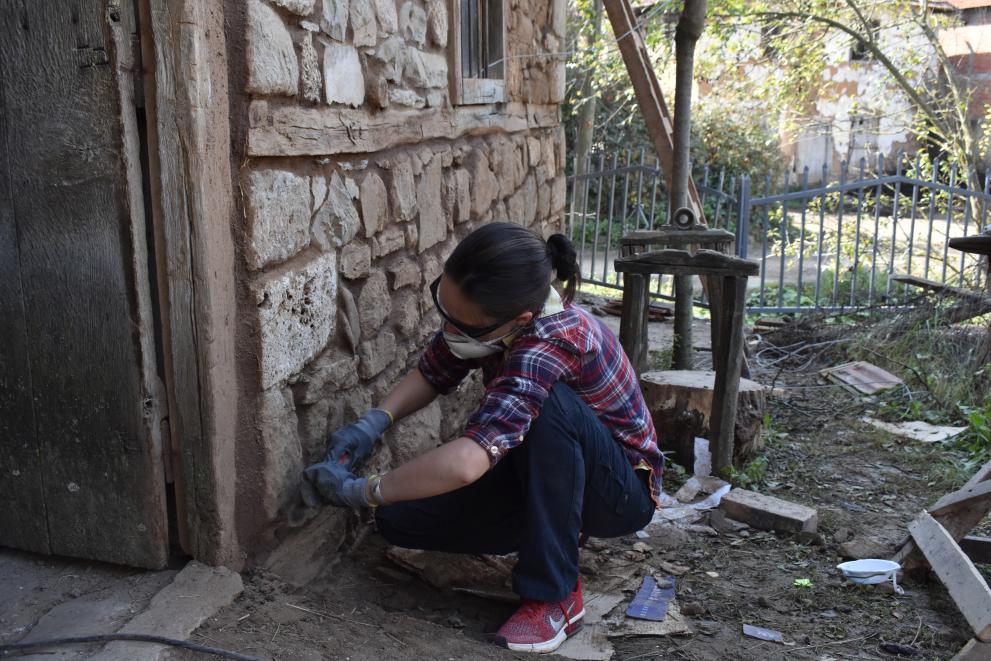Every day, over 30 students from universities in Prishtinë/Priština, make the pilgrimage from their base in Gjilan/Gnjilane as a part of the Letnicë/Letnica Heritage Lab. Many of them have rarely had the opportunity to partake in practical fieldwork like this before. The students, in cooperation with their professors, have been drafting and implementing a plan to revitalise the mill and the area around it.

Students are at the heart of the restoration process. Photo: UNDP/ Sebastian Sherrah.
Restoring the centuries old Mill of Frok Dokic
Nita Llonçari is a student of architecture at the University of Prishtina and is responsible for repointing the 150-year-old mill’s stonework: “There was cement over the rocks and it was destroying them and since cement is much harder, when water comes in, it can only escape through the rock”.
The water causes the stonework to become porous and brittle, which has damaged most of the mill. The stones are being repointed with locally sourced mortar, which will ensure that water can escape without damaging the wall.
Nita believes that the camp will have a positive effect on the whole town, “we are putting Letnicë/Letnica on the map, and maybe people can come here and bring money to invest, like open restaurants.”

Nita Llonçari carefully removes the old concrete before replacing it with mortar. Photo: UNDP/Sebastian Sherrah.
Local residents discover the unique story of Letnicë/Letnica and restore local infrastructure
Letnicë/Letnica has long been a historical centre for the Croatian community of Kosovo. They say that within the walls of the church just a few meters above, Mother Teresa received her revelation from God and subsequently devoted herself to a life of service.
The project also has a team of sociologists, anthropologists and ethnologists who are retelling the unique history of Letnicë/Letnica and its local landmarks, through stories, films and photographs. However, it is not only the mill that is being rehabilitated, the small bridge that connects the town and the mill is a part of the project.
“When we started, the bridge was in terrible condition, it wasn’t safe for the villagers [to cross]” said Asdren Spahija, a fourth-year student of architecture, “we are trying to create something sustainable and safe, using materials found in the local area, but something that is also attractive”.
For Asdren, the camp is a unique opportunity to get out of the classroom and get his hands dirty: “We learn about all this stuff in paper but never in the field and we were very eager to get involved with the project, [now] it’s like our baby” he said.
For others like Besa Talla, this project is about protecting and celebrating Kosovo’s cultural heritage: “I saw this as a great opportunity because I really like our history and I want to keep it safe. When we will fix this area, people will come here because they hear about the mill and will know more about the history of their place, and this way our place will have an identity.”
For Besa Talla, and the other participants, it has been an invaluable experience in developing their professional abilities and preserving Kosovo’s cultural heritage: “I hope they make more workshops like this because I can’t wait to apply again”.

The students are also building a small sitting area outside the mill. Photo: Jetmir Idrizi.
The mill will also serve as a community museum
When the mill has been fully restored, it will serve an additional purpose, as a small museum dedicated to the production of bread. Karolina Dokic, the daughter of the mill’s owner, will donate some 20 pieces of her personal collection to the museum. Through this project, the mill will serve its original purpose, as it has for the past 150 years, but also take on a new form. A place to celebrate the history of Letnicë/Letnica, the unique story of its people and the simple pleasures of the perfect loaf of bread.
Sehadin Shok, UNDP ‘Inter-community Dialogue Through Inclusive Cultural Heritage Preservation’ Project manager, said, “The camp has been a big success, and this is the first of five, so we are looking forward to seeing more young people engaged over the next year.”
The Letnicë/Letnica Heritage Lab was hosted by Cultural Heritage Without Borders - Kosovo. The Lab is funded by the EU’s Instrument contributing to Stability and Peace (IcSP) as part of the ‘Inter-community Dialogue through Inclusive Cultural Heritage Preservation’ project and is implemented by UNDP in Kosovo. The camp was also supported by the OSCE Mission in Kosovo.
Managed by the European Commission’s Service for Foreign Policy Instruments, the Instrument contributing to Stability and Peace (IcSP) provides short- and mid-term assistance on conflict prevention, crisis-response and peace-building actions around the world. There are currently around 200 projects in over 75 countries. IcSP projects are implemented by Non-Governmental Organisations, the UN and other International Organisations, EU Member State agencies and regional and sub-regional organisations.
The story was originally published by UNDP Kosovo.
For more information
The EU’s Instrument contributing to Stability and Peace (IcSP)
